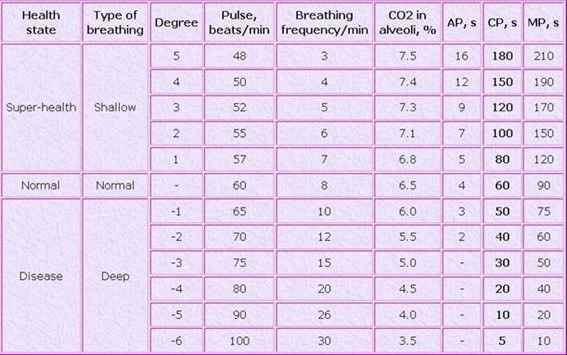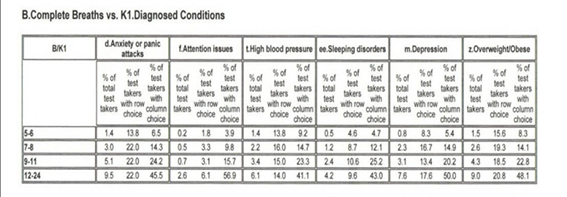With approaching death, breathing becomes faster while oxygen levels in the brain and other cells become lower and lower. Very high respiratory rates (labored breathing) are evident in terminal cancer, the last stages of HIV-AIDS, cystic fibrosis, and other conditions.
Observing breathing patterns in dying hospital patients led to the discovery of the Buteyko breathing method, which is about slowing down your heavy breathing back to the medical norm. Today, very few people breathe anywhere near the old medical standard, which 70 years ago was eight breaths a minute. Labored breathing is a regular feature of severe disease.
When people are anxious, they tend to take rapid, shallow breaths from the chest. This breathing pattern is called thoracic (chest) breathing, which can disrupt oxygen and carbon dioxide levels in the body, resulting in increased heart rate, dizziness, muscle tension, and other physical sensations. This may signal a stress response and contribute to anxiety and/or panic attacks.
When we allow CO2 levels to rise back to normal levels
we are allowing oxygen levels also to return to normal.
The American Academy of Cardiology says, “Stress can cause shortness of breath or make it worse. Once you start feeling short of breath, it is common to get nervous or anxious. This can make your shortness of breath even worse. Being anxious tightens the muscles that help you breathe, and this makes you start to breathe faster. As you get more anxious, your breathing muscles get tired. This causes even more shortness of breath and more anxiety. At this point, you may panic.”
Blood gases and respiratory patterns provided accurate
information for survival prognosis in acute cerebrovascular
accidents. When these parameters are normal, patients survive.
“The combination of hyperpnoea [increased breathing] with an elevated pH and a subnormal or moderately low oxygen tension occurs in many serious illnesses that entirely spare the brain. These include the alveolar-capillary block of diffuse pulmonary carcinomatosis; heart failure; advanced cirrhosis, with or without hepatic coma; acute pulmonary infarction; and many others, including the cryptic pulmonary congestion that accompanies most serious disease in the obtunded and elderly” (Plum, 1972).
A group of US medical professionals found that the degree of heavy breathing has a strong correlation with overall mortality (Mazarra et al., 1974). Heavier breathing indicated smaller chances of survival.
While everyone feels anxious from time to time, one in five people lives under the influence of a potentially debilitating anxiety disorder. That was in pre-COVID days. Now we have stupid and cruel governmental pandemic responses, extremely dangerous vaccines, exploding energy and food prices, threatened financial and economic armageddon, and so much more, including violent climate change (cold), all sending human anxiety to the stratosphere.
While anxiety symptoms vary from person to person, all types of stress can potentially affect your breathing patterns and increase your heart rate. There is little doubt that the collective of humanity is more stressed and thus breathing faster. Mental and emotional health is also suffering, so it makes sense to focus on breathing to address what is happening to us on physical, emotional, mental, and even +spiritual levels.
Medical studies have proven that the more we breathe
the less oxygen is provided for the vital organs of the body.

Many people have experienced episodes that made it feel nearly impossible to catch their breath. It’s frightening and very real. Anxiety can affect our ability to breathe, and the way we breathe can also influence our anxiety levels. However, you can take control of the way you breathe to minimize anxiety breathing symptoms. Respiratory training is a very effective way to restore the body’s health at any age and should be part of the protocol of everyone dealing with chronic diseases and COVID and the flu.
Slow Breathing and Cancer
A clinical study in Russia conducted by Dr. Sergey Paschenko was published by the Ukrainian National Journal of Oncology. The elimination of hyperventilation and hypocapnia in patients with breast cancer through slower breathing led to an increase in the three-year survival rate and a better quality of life of patients. In this study, when a modified breathing retraining technique was applied, the three-year mortality rate for the breathing normalization group was 4.5% and for the control group 24.5%. Hence, breathing normalization decreased 3-year mortality by more than five times. All patients who normalized their breathing survived. Let’s add another 30% chance of beating one’s cancer just from spending an hour a day using a Russian breathing device designed for asthmatics.
Vernon Johnston cured himself of prostate and
bone cancer in a month with sodium bicarbonate
and four hours a day of conscious breathing.
Too Much Breathing is Tiring & Sickening

Our vital capacity for breathing is directly related to our breathing rate and is a predictor of health, illness, and longevity. After thirty years of studying over 5,000 patients in the Framingham studies, doctors from the Boston University School of Medicine said they could predict both long-term and short-term mortality based on peoples’ breathing capacity. Dr. William Kannel said a person’s vital breathing capacity can “Pick out people who are going to die 10, 20 or 30 years from now.”
A person who is breathing at four breaths a minute will only breathe about 5,760 times a day. At the “normal” breathing rate of eight breaths a minute, that count doubles to 11,520 breaths a day. At 16, which is still slow for many ill people, that rate reaches 23,000 breaths a day. At 25 breaths a minute, we are clipping along at 36,000 breaths a day, which is a far cry above a normal rate.
Dr. Buteyko found that virtually all sick people (asthma, bronchitis, heart disease, diabetes, cancer, etc.) have accelerated respiratory patterns. During rapid breathing, carbon dioxide becomes deficient, oxygen delivery to the cells is reduced, breath-holding time is reduced, and the natural automatic pause is absent in each breath. Buteyko appreciated that breathing is in control and modulates the body’s cardiovascular, immune, nervous, and digestive systems.
We can improve the functioning and efficiency of our heart, lungs, and other internal organs and systems with better breathing. Therefore, breathing correctly is essential if you want to live longer. In addition, conscious-centered breathing gives us the ability to maintain positive emotions as well as spiritual balance. Thus, we can transform our stress and negativity.
Get hold of your breath and harness it for healing.
Breath is life, so we can expect to feel more alive, vibrant, and healthy if we bring our awareness to our breath and retrain the way we breathe. We can live more perfectly in health when we breathe perfectly because our breath is the most crucial energy source. Hippocrates said, “Air is a pasture of life and the greatest ruler of all.”
I recommend the Frolov. It makes breathing retraining easy. I like to say to people that an hour a day on the Frolov is like four hours of more unstructured breathing exercises because it is hard to imagine many people, even those dying of cancer, having the will to breathe four hours a day like Vernon Johnston.
Becoming a slow breather will change a
person’s life. It will change their consciousness.
Conclusion
Bottom line—the quicker we breathe, the sooner we die. The more our breathing races, the less oxygen we get, the faster our bodies begin to suffer from one chronic ailment or another. Eight breaths a minute is very healthy though few breathe today slower than 12. Cancer patients tend to breathe at 18 to 25 breaths a minute.
Al Lee and Don Campbell, in their book Perfect Breathing, say it well. “The impact of the breath extends into every aspect of life and shows itself at the root of human function. Ancient teachers, sages, yogis, and martial artists discovered its power and developed disciplines around it with yoga and qigong, and karate, among so many other practices. Understanding the breath means understanding the human-machine and how each breath can be used to develop and control the body. Breathing forms the foundations of meditation, contemplative thought, and prayer, but it is also informing science and medicine, as conscious breathing proves its mettle as a tool to fight stress, build up immunity to disease, and heal the body in many ways.”
We all can listen when Lee and Campbell say, “What is a perfect breath? Far from being some noble yet unreachable goal that takes years of rigorous practice to master, a perfect breath is any breath you take for which you are completely mindful and aware. In the space of that one simple breath, great things can be accomplished. Perfect breathing is absolutely attainable and within easy reach. In fact, your very next breath can be a perfect breath.”
We can move medical mountains simply by adjusting the breath. Doctors can be superheroes without all the pharmaceuticals by giving their patients a simple breathing device that offers them a non-toxic, inexpensive, non-invasive, natural way to instantly reduce stress hormones, calm emotions, boost oxygen levels, gently massage internal organs, let go of stress, assist in returning to their centers, relax muscles, detox the body and improve the overall efficiency of the organs and body. That’s in addition to increasing cell voltage and improving pH.
Reprinted with permission from Dr.Sircus.com.




